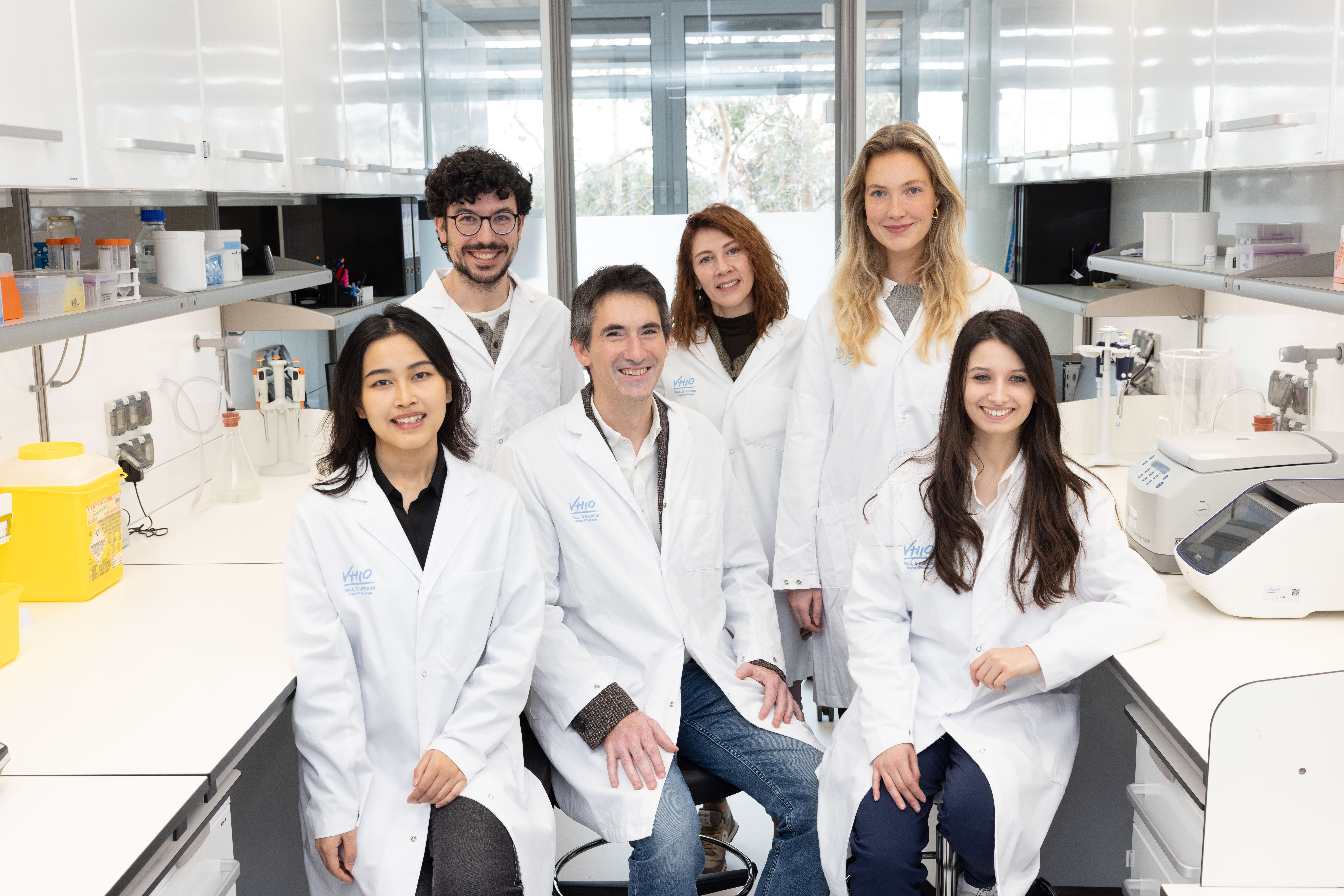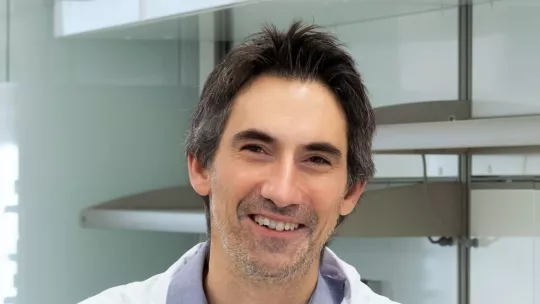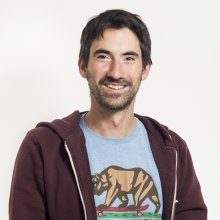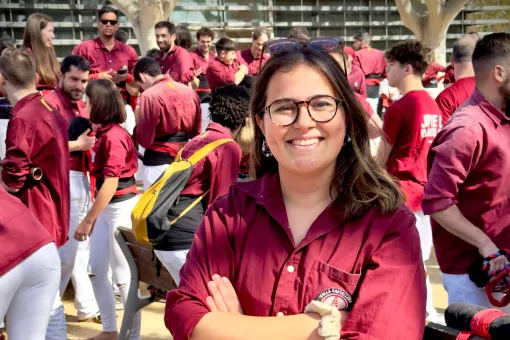Images
Born in Hungary in 1981, Dr. Mate Maus graduated in Life Sciences from the Eötvös Loránd University in 2006 and was awarded a PhD in Immunology from the same university in 2010.
After a 5-year postdoc period in the US, in 2017 he joined the Cellular Plasticity and Disease lab at IRB Barcelona, headed by Dr. Manuel Serrano, as a Postdoctoral Fellow.
In January 2023, he was appointed Group Leader of the Aging and Cancer Group at the Vall d’Hebron Institute of Oncology (VHIO).
"IRB Barcelona hosts some exceptionally brilliant minds, who together have created an ideal environment for young scientists daring to think big".
Mate, tell us about the Aging and Cancer Group that you lead at the VHIO.
The group, which currently comprises 3 PhD students, a lab manager, and a master's student, was launched in January 2023 with a generous start-up package from VHIO.
We study the metabolic changes that happen with ageing and their link to cancer development.
The cell microenvironment is key to cancer cell progression. We use cutting-edge technology, in vivo mouse models of both cancer and ageing, and samples from human cancer patients to study how ageing of the tissue microenvironment favours malignancy and inhibits anti-tumour immunity.
Our mission is to put ageing research to the service of oncology practice by developing novel, innovative technologies capable of identifying and targeting age-related alterations in the tissue microenvironment that promote malignancies.

Let’s go back to the start of your research journey. After completing your PhD in Hungary, how did your first postdoc in the US come about?
During my PhD, my department acquired a confocal microscope, which was a game changer for me because it was possible to see the tiny events in a cell and do live cell imaging.
I started to experiment and I observed that as the cells increased calcium signalling their shape changed. These changes in morphology fascinated me, so I began to explore the biology behind the process, and I published a small paper on it. This caught the attention of Dr. Stefan Feske at the New York University (NYU), and in 2011 he invited me to join his group.
What did you study there?
There, I focused on patients with inherited immunodeficiencies, where their immune cells for reasons unknown failed to protect against infections or cancers. A common thread among these patients was that each of them inherited mutations in their calcium signalling machinery.
Calcium signalling plays a vital role for cells, akin to how nerves function for the brain, they transmit information coming from the outside world to enable cellular responses. Through a series of studies, we discovered that the calcium signalling component missing in these immunodeficient patients conveyed crucial signals of metabolic growth to immune cells.
Much like muscles in athletes, immune cells require increased nutrient intake when meeting a challenge. However, in the absence of this signalling element, immune cells fail in their ability to support the metabolic demands of multiplying and they cannot fight viruses or cancer. Despite recognizing the invaders, the immune cells in the patients we studied failed to respond appropriately because they couldn't interpret the signal prompting their growth.
What brought about your move from the US to Spain?
In 2016, my partner and I decided that we were ready to try starting a family and that therefore it was time for us to return to Europe. My partner got a job in Madrid. So I started to explore the research groups in Madrid and I was pointed in the direction of Dr. Manuel Serrano, a brilliant scientist who was then working at the Centro Nacional de Investigaciones Oncológicas (CNIO) (I moved with him from there to IRB Barcelona in 2017). I reached out to him and we conversed through emails, upon which he invited me to join his lab.
With Dr. Serrano, I started to work on the metabolism of ageing and how it leads to fibrotic diseases.
Can you tell us about fibrotic disorders?
One out of every three individuals will die due to fibrotic disorders. Fibrosis occurs when the switch-off signal for tissue repair gets stuck. As a result, functional cells in an organ get progressively replaced by scar tissue in an aberrant attempt to repair the organ, which ultimately leads to organ dysfunction.
Fibrosis can manifest in many forms and it contributes to heart attacks, kidney disease, atherosclerosis, liver steatosis, and many other conditions. We discovered that, for reasons not entirely understood, fibrotic organs accumulate a lot of iron. We found that this accumulation maintains inflammation and promotes fibrosis. Our data suggest that iron accumulation may be a promising new target for innovative diagnostic tools and therapeutics in fibrotic diseases.
At this point, we think it would be timely to congratulate you on that discovery and your recent publication in Nature Metabolism (December 2023). What was it about?
We described the pivotal role of iron accumulation in the development of fibrotic diseases, which are responsible for 30-40% of deaths in developed countries.
We studied the link between iron accumulation, senescence (a phase where cells neither divide nor die), and the Senescence-Associated Secretory Phenotype (SASP) - a communication system in ageing cells that prompts them to release harmful molecules.
We demonstrated the potential of iron detection via magnetic resonance imaging (MRI) for non-invasive assessment of fibrotic burden in patients with renal fibrosis. We also uncovered the potential of chemical compounds able to remove the accumulated iron, such as deferiprone (a clinically approved drug), to prevent fibrosis, thereby pointing to a new approach for treating fibrotic diseases.
Let’s return to the concept of “ageing” (and also disease), which is part of the name of your group.
For many diseases - a lot of which are non-communicable - age is by far the best predictor. However, consensus remains elusive regarding the fundamental cause of aging.
There are many theories each with their own validity. One line of thought is that the number of injured cells (senescent cells) increases with ageing to such an extent that it overwhelms the repair capacity. Advocates of this theory propose that removing these damaged cells could rejuvenate the organism, potentially extending lifespan.
Alternatively, another school of thought posits that ageing stems from cellular forgetfulness, leading to a gradual decline in cellular function and thereby impeding overall organismal health. Proponents of this view advocate for cellular reprogramming, a process aimed at resetting or rewriting cellular memory, as a potential avenue for prolonging lifespan.
Insights gained from evolutionary biology and comparative studies of species' lifespans consistently hint towards the notion that maximum lifespan may be encoded in our genes. Such research consistently reveals that longer lifespans correlate with enhanced mechanisms for safeguarding and repairing DNA from damage. These studies suggest a limited scope for human lifespan extension without tampering with genomic integrity.
What are your thoughts about increased public interest in anti-ageing and the possibility of extending human lifespan?
I understand and share the natural desire to live a long and healthy life. One interesting question is whether we have extended lifespan at the population level and what we actually accomplished.
Statistics show that average life expectancy has dramatically increased over the last century, but maximum lifespan has not. The longest-lived people are the same age now as 100 years ago…. So this observation would suggest that there are certain limitations to longevity.
From an evolutionary perspective, all organisms are subject to a single pressure, namely reproduction, in such a way that the number of living offspring must equal or exceed the number of individuals dying.
Can you tell us about this theory?
Brazilian-British evolutionary biologist Peter Medawar (1915–1987) posited that aging doesn't evolve for the benefit of the species; rather, it evolves because once individuals successfully pass on their genetic information to their offspring, evolutionary pressures cease to act upon them.
Put simply, there is no selective pressure on the genome of species to maintain functioning beyond the age of fertility. Consequently, upon exiting fertility, the process of ageing starts.
Medawar's hypothesis gained empirical support through his experiments with the fruit fly Drosophila melanogaster.
By delaying their reproduction until late in life, he succeeded in producing long-lived flies. This genetic shift from short- to long-lived individuals can occur within a few generations, as evidenced by closely related fish species inhabiting African lakes that experience periodic drying.
These fish species show extreme differences in life expectancy, with the onset of ageing determined by the duration of water availability in their respective habitats.
Intriguingly, when brought into laboratory settings, these fish maintain their lifespan, suggesting that while their lifespan was set by the fertility period their environment permits, it became encoded in their genes.
So it’s interesting to consider the following: if Medawar is right, having our children at later ages (which is an increasing trend in developed countries) would extend human lifespan, and ultimately this evolutionary process would select long-lived human individuals.
What do you think will be the breakthroughs in your field of research in the next 10 years?
I think one of the pressing questions revolves around understanding the interplay between ageing and pre-cancerous cells. Thanks to the significant advancements in sequencing technology over the past decade, we have uncovered that cells harbouring cancerous mutations are frequent and they are present in us all.
Nevertheless, most of us luckily do not develop cancer, and if we do, we do later in life. These revelations challenge our traditional view of cancer solely as a disease driven by genetic mutations. They force us to think about the interaction between the microenvironment surrounding a cell and the genotype it carries.
This emerging discipline integrates the study of cancer with ageing, offering profound insights that could revolutionize cancer treatment and diagnosis. Rather than solely targeting cancer cells, this novel approach entails addressing the cellular microenvironment, potentially even before cancer manifests.
Modulating this microenvironment in various ways presents promising avenues for oncological practice, offering hope for more effective and personalized treatments. Indeed, this is precisely the focus of research within my group.
Let's go back to your time at IRB Barcelona. How did it help you to advance your research interests?
IRB Barcelona hosts some exceptionally brilliant minds, who together have created an ideal environment for young scientists daring to think big. For big ideas to take root, one also needs the right soil, much of which in biomedicine is about having access to core technologies.
My research would never have been possible without the fantastic work of the IRB Barcelona Histopathology Facility, managed by Dr. Neus Prats, the Bioinformatics Unit, led by Dr. Camille Stephan-Otto Attolini, and the Functional Genomics Facility, managed by Dr. Freddy Miguel De Oliveira.
Are you still in contact with IRB Barcelona and, if so, in what form?
I regularly go back to IRB Barcelona, partly because my new lab has collaborations running there and because, thanks to the Alumni programme, I can use some of the Institute's core services! I also come back regularly because there are so many people there whom I like or outright admire.
What special memories do you have of IRB Barcelona?
My years at IRB Barcelona, under the mentorship of Dr. Manuel Serrano, were undeniably transformative in many ways. During that period, I became a father, a miracle for which I am immensely grateful.
Generally, my time at the IRB Barcelona coincided with a period in which I became a calmer individual. Meditation played a vital role in this process.
From a career perspective, I found my science under the mentorship of Dr. Serrano and this would have been impossible without the support of IRB Barcelona´s core facilities, technologies, and job security. I am very grateful for all this.
About IRB Barcelona
The Institute for Research in Biomedicine (IRB Barcelona) pursues a society free of disease. To this end, it conducts multidisciplinary research of excellence to cure cancer and other diseases linked to ageing. It establishes technology transfer agreements with the pharmaceutical industry and major hospitals to bring research results closer to society, and organises a range of science outreach activities to engage the public in an open dialogue. IRB Barcelona is an international centre that hosts 400 researchers and more than 30 nationalities. Recognised as a Severo Ochoa Centre of Excellence since 2011, IRB Barcelona is a CERCA centre and member of the Barcelona Institute of Science and Technology (BIST).






